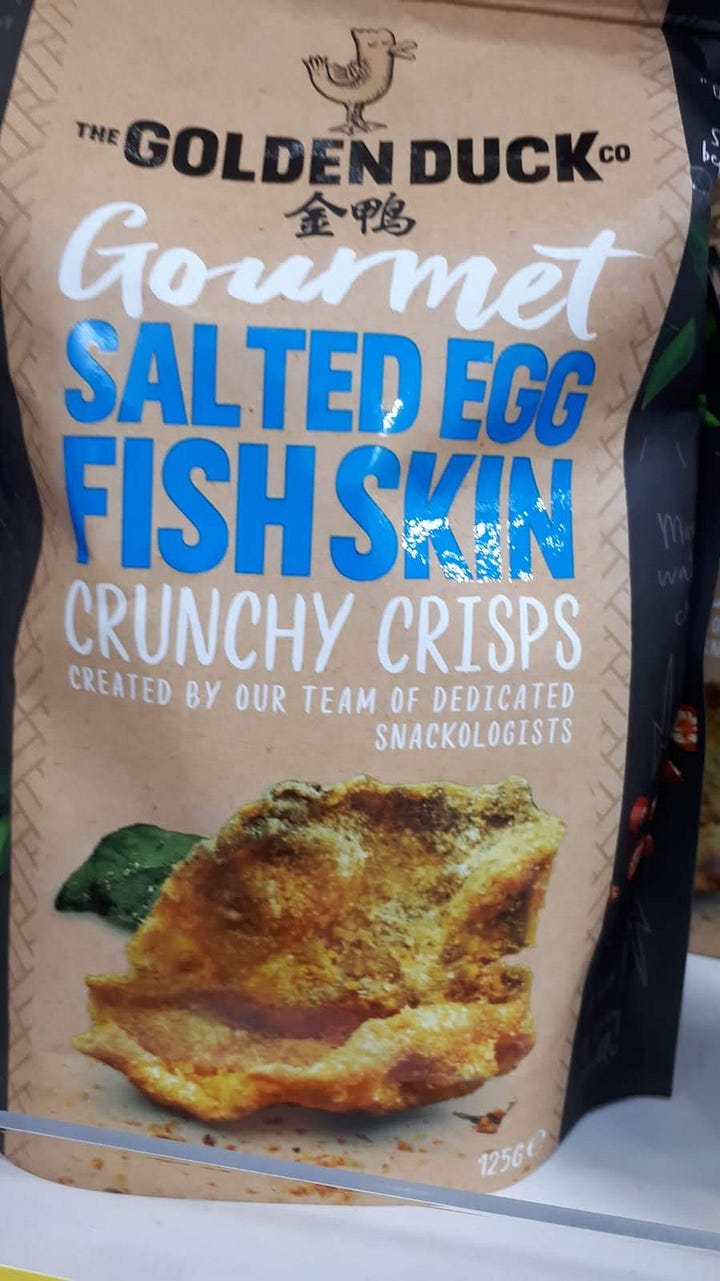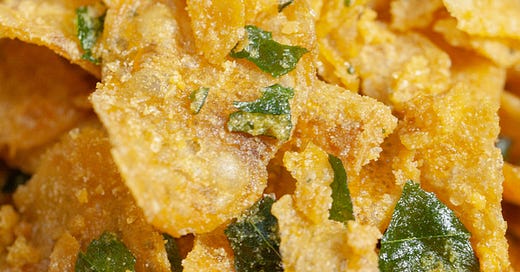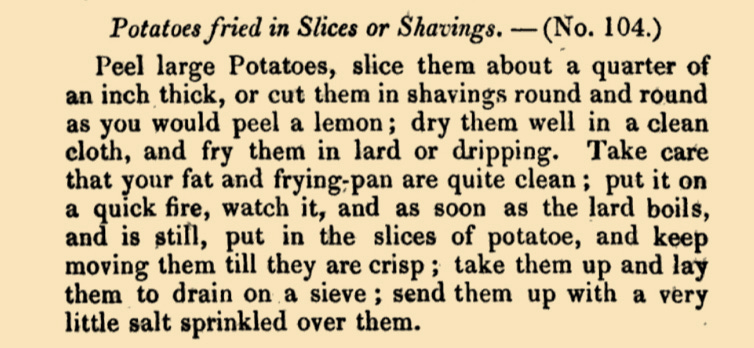I’m baffled by the fact that Haggis & Black Pepper Crisps feature on internet lists of the world’s weirdest snacks. There’s nothing about them that begins to compare in weirdness to the Fish & Chip Gelato popular with Australians. Or the deep fried tiny crabs in sugar that play the role in Japanese bars of beer-nuts. Then again, how about Wasabi Cheese doughnuts? Singaporeans adore them.
Snacks of all sorts are hugely profitable. But crunching chip figures alone, it is estimated the global market in 2025 will be worth over $44 billion. Just in the US, the potato chips market is currently worth $10.15 billion. In Britain, where the main brand Walkers produces over 10 million packets a day, over 6 billion single-person crisp packets are eaten annually.
The Incas would have been amazed.
At Christmas, I don my Santa hat to raid the Asian markets in my area for bizarre packaged snacks to stuff the family’s stockings. But I never can beat the eccentric snacks on sale in South East Asia itself - bags of crunchy things you’d never think anyone would consider activating a factory assembly line to create. I hate egg. Yet Irvins Salted Egg Crisps and Irvins Salted Egg Fish Skin are among the most fabulous things you can put in your mouth.


I don’t know what it is about that part of the world that encourages entrepreneurial citizens to spend their time and hard-earned savings in devising things to eat that surely cannot come naturally to anyone as logical taste pairings.
Founder of Irvins, Indonesian entrepreneur Irvin Gunawan, began in 2009 with a seafood restaurant in Singapore specialising in local dishes. One of his most popular was its signature Salted Egg Crab. When the restaurant was forced to move location to a less favourable one, it struggled. In the kitchen during 2014, the family experimented with new dishes to attract new customers, and came up with the strangely wonderful salty-sweet salted egg potato chips and salted egg fish skin. Queues formed outside the restaurants just to buy those, and Irvin launched pop-ups around Singapore devoted exclusively to them. Probe your local Asian supermarket for some.
And people think the Brits are weird for their love of Prawn Cocktail Crisps? But that’s about as ‘weird’ as British crisps get. In the sector of the common-or-garden crisp there are over 1000 flavours. Korean Honey Butter Potato Chips with that Negroni? I don’t think so, although I might accommodate Korean Cuttlefish Crackers.
Except, living in the UK, I couldn’t. Really intriguing chips aren’t available. Walkers Crisps, a company founded in 1948, is Britain’s top supplier. In 1970, it was sold to America’s Standard Brands, then on, in 1989, to Pepsi Cola’s Frito-Lays division. Brits are happy to buy Walker’s Crispy Roast Chicken, and Sizzling Smoky Bacon, so why aren’t some of Lay’s other temptations available in the UK? How about Roasted Garlic Oyster Flavor chips, so popular in China? Or Braised Lion Head Flavor. Or Pickled Fish Flavor. Surely Lay’s Crispy Roast Suckling Pig and its Roasted Cumin Lamb Skewer Flavor would go down well at British pubs pre-Sunday lunch, though not, perhaps, its Durian or Wasabi Octopus. There are over 200 different flavours in Lay’s canon, but the UK is offered only the most obvious which compete with exactly the same tastes carried by rival brands - although Walker’s Cajun Squirrel, and Builder’s Breakfast did appear briefly on British supermarket shelves.
We know eating snacks is wrong - I write about the effects of ultra-processed foods perhaps more than you would wish. But I am not a supporter of deprivation. I swing between making my luxury on Desert Island Discs (when I’ve become famous enough to be invited on that classic British radio show with my list of favourite tracks) a fully made up canopied four-poster bed so I don’t have to build a hut, or a lifetime supply of Salt & Vinegar crisps.
Salty, sweet or fatty foods activate the region in the brain responsible for motivation and reward. Endorphins, which enhance mood and reduce pain, and dopamine, linked to pleasure and satisfaction, are released into our bodies, making us feel good - and in the mood for yet more crisps or chocolates, which is the problem with them.
George Crum, chef at Moon’s Lake House in Upstate New York, would have known none of this when, in a spirit of seething fury I’m guessing, he invented the first crisp in 1853 in response to a diner’s complaint that his fried potatoes were too thick and flabby. By the turn of the century, plain salted ‘Saratoga Chips’ were being mass produced.
Flavoured crisps arrived in the 1950s, led by UK makers Smith’s, who brought in Salt & Vinegar chips in 1954, then Cheese & Onion. Lay’s introduced BBQ chips to the US in 1967 and Sour Cream & Onion in the 1970s. Weird flavours like Nacho Cheese and Ranch, borrowed from nacho chips, emerged in the 1980s, the decade Canadians went nuts for Ketchup. By the end of the 1990s, Dill Pickle chips and Chili chips had appeared, with Lime & Chili launched in 2003, followed by Wasabi, Curry, Buffalo Wing, and Maple Bacon. In 2012, Sriracha were introduced, with Chicken & Waffles and Wasabi Ginger devised by consumers. Truffle followed at the high end. Not sure I want Cinnamon Sugar chips but would prefer them to Cappuccino chips or the chocolate-coated chips of Minnesota company Old Dutch Foods, created in 1985. I would eat any of them, however, before I spent money on Japan’s ‘Wet Potato’ - yes, moist chips! - or Brussels sprouts-flavoured Pringles.
Chips and other snacks, whatever their flavour, are not healthy. Their additives, their fats, salts, and sugars are addictive. They have been deliberately manipulated to make us want more, because obviously that’s how snack companies make their profits.
Vegetable crisps, from beetroot, parsnips and sweet potato, are touted as better for us, as are fruit crisps. It’s not necessarily the case. Potatoes have more protein and the other root vegetables have a higher carbohydrate and sugar content. By the time both have been cooked, they have a similar fat and salt or sugar content.
If I’m going to voluntarily submit myself to a glut of unhealthiness, what I want is fun. And flavour. Bring on Irvin’s Salted Egg Fish Skin Crunchy Crisps.
For a different kind of fun, this historic crisps/chips recipe comes from The Museum of Crisps, an online site.
If you long for a crisp or chip, here is how to reduce their unhealthiness just a little. The quantity makes enough for 4 unless you’re a complete addict.
1-2 scant tablespoons vegetable oil
1 large potato sliced paper thin on a mandolin, skin on or off as you wish
salt to taste
Pour the oil into a microwave or freezer bag. Wipe the potato slices between two sheets of paper towel. Add them to the bag and rub them all around from the outside to coat evenly in oil. Keeping the slices inside the bag, swipe the greasy interior of the bag round a platter to oil it. Arrange potato slices in a single layer on the prepared plate. You will have to do this in batches.
Cook in the microwave on high until lightly browned, 3 to 5 minutes. Remove chips to a large bowl and toss with salt. (Or cayenne pepper. Or five-spice powder. Or mustard powder. Or garlic powder. Or any something else Lay might add.) They will crisp up as they cool and make a majestic partner to a cocktail.









It’s funny; every time I’m in the UK I think to myself, “why can’t I get such interestingly flavored chips at home [in the US].”
Enjoyed this very much. Now desperate to try Salted Egg Crisps and absolutely will be nabbing that stocking idea. It’s a shame that English tastes are perceived as so limited — but perhaps it’s also the truth? British cuisine isn’t exactly punchy (though it does comfort pretty well). But yes: let snacks be fun.